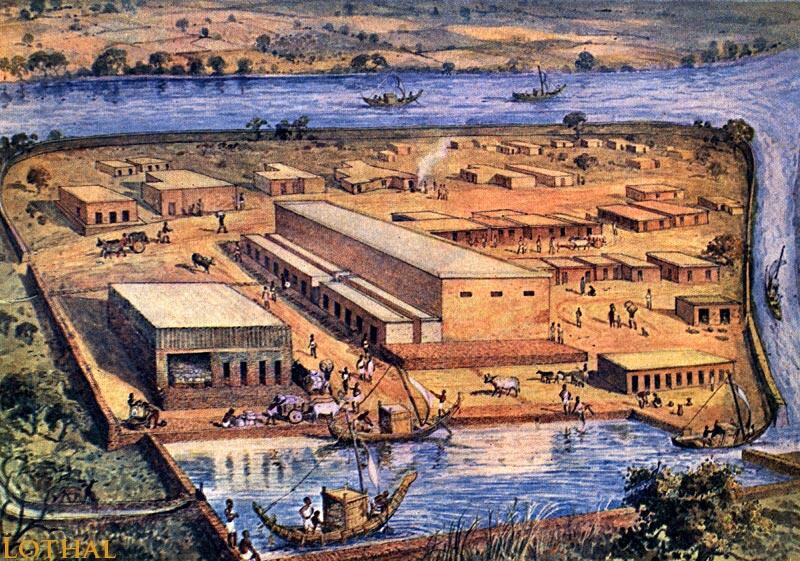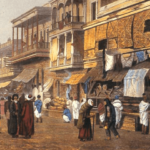Oldest name-Indus Civilization
According to archaeological tradition, the most appropriate name-Harappan Civilization (Harappa-the first discovered site).
According to geographical point of view, the most suitable name-InudsSaraswati Civilization (the largest concentration of settlement-along the Indus-Saraswati river valley; 80% settlement along the Saraswati).
>> The most accepted period — 2500 BC-1750 BC (by Carbon-14 dating).
>> John Marshall was the first scholar to use the term ‘Indus Civilization’. The Indus Civilization belongs to Proto-Historic Period (Chalcolithic Age/ Bronze Age).
The Northern-most site of Indus Civilization-Ropar(Sutlej)/Punjab (Earlier); Manda (Chenab)/Jammu-Kashmir (Now). The Southern-most site of Indus Civilization-Bhagatrav (Kim)/Gujarat (Earlier); Daimabad (Pravara)/Maharashtra (Now). The Eastern-most site of Indus Civilization-Alamgirpur (Hindon)/Uttar Pradesh. The Western-most site of Indus Civilization-Sutkagendor (Dashk)/Makran Coast (Pakistan-Iran Border).
Capital Cities-Harappa, Mohenjodaro
Port Cities-Lothal, Sutkagendor, Allahdino, Balakot, Kuntasi
| Site | River | District | State / Province | Country | Excavated By/ Founded by |
| Harappa | Ravi | Sahiwal | Punjab | Pakistan | Daya Ram Sahni (1921), Madho Swaroop Vatsa(1926),Wheeler (1946) |
| Mohenjodaro (Nakhlistan i.e Oasis of Sindh) | Indus | Larkana | Sindh | Pakistan | Rakhal Das Bannerji . (1922), Mackay (1927) Wheeler (1930) |
| Chanhudaro | Indus | Nawabshah | Sindh | Pakistan | Mackay (1925),N.G.Mazumdar (1931) |
| Lothal | Bhogava | Ahmedabad | Gujarat | India | S.R. Rao (1954) |
| Kalibanga (i.e. the bangles of black colour) | Ghaggar | Hanumangarh | Rajasthan | India | Amalanand Ghos(1951),B.V. Lal and B.K.Thapar (1961) |
| Banawali | Ghaggar | Fatehabad | Haryana | India | R.S Bisht (1973) |
| Dholavira | Luni | Kutch | Gujarat | India | J.P.Joshi (1967-68) |

| Site | Archaeological Finds |
| Harappa | 6 Granaries in row, Working floors, Workmen’s quarters, Virgin-Goddess (seal), Cemetry (R-37,H), Stone Symbols of Lingam (male sex organ) and Yoni (female sex organ), Painted pottery, Wheat and Barley in wooden mortar, Crucible for bronze, Copper scale, Clay figures of Mother Goddess,Vanity Box, Copper-made Mirror, Dice |
| Mohenjodaro | Great Bath (the largest building of civilization), Assembly Hall, Great Granary, Shell strips, Pashupati Mahadeva/ Proto Shiva (seal), Bronze Image of a nude woman dancer, Steatite image of bearded man, Painted seal (Demi-God), A fragment of woven cotton, Brick Kilns, Clay figures of Mother Goddess, Human skeletons huddled together, 2 Mesopotamian seals, 1398 seals (56% of toal seals of civilization), Dice. |
| Chanhudaro | City without a citadel, Inkpot, Lipstick; Metal-workers’, shell-ornament makers’ and bead-makers’ shops; Imprint of dog’s paw on a brick, Terracotta model of a bullock cart, Bronze toy cart. |
| Lothal | Dockyard, Rice husk; Metal-workers’, shell-ornament makers’ and beadmakers’ shopes; Fire altars, Terracotta figurine of a horse, Double burial (burying a male and a female in a single grave), Terracotta model of a ship, Dying vat, Persian /Iranian seal, Baharainean seal, Painted jar (bird and fox). |
| Kalibanga | Ploughed field surface (Pre-Harappan), 7 Fire altars, Decorated bricks, Wheels of a toy cart, Mesopotamian cylindrical seal. |
| Banawali | Lack of chess-board or gridiron pattern town planning, Lack of systematic (drainage system, Toy plough, Clay figures of Mother Goddess. |
| Dholavira | A unique water harnessing system and its storm water drainage system, a large well and a bath (giant water reservoirs), Only site to be divided into 3 parts, Largest Harappan inscription used for civic purposes, A stadium. |
| Surkotada | Bones of horse, Oval grave, Pot burials. |
| Daimabad | Bronze images (Charioteer with chariot, ox, elephant and rhinoceros) |
>>Mohenjodaro – the largest site of Indus Civilization, Rakhigarhi-The largest Indian site of Indus Civilization.
Common Features of Major Cities : 1. Systematic town-planning on the lines of ‘grid system’ 2. Use of burnt bricks in constructions 3. Underground drainage system (giant water reservoirs in Dholavira) 4. Fortified citadel (exception Chanhudaro).
>>Surkotada (Kutchh district, Gujarat) : the only Indus site where the remains of a horse have actually been found.
>> Main Crops : Wheat and Barely; Evidence of cultivation of rice in Lothal and Rangpur (Gujarat) only. Other Crops : Dates, mustard, sesamum, cotton etc. Indus people were the first to produce cotton in the world.
>>Animals : Sheep, goat, humped and humpless bull, buffalo, boar, dog, cat, pig, fowl, deer, tortoise, elephant, camel, rhinoceros, tiger etc.
>>A very interesting feature of this civilization was that Iron was not known to the people.
>>The Sumerian texts refer to trade relations with ‘ Meluha’ which was the name given to the Indus region.
>>Shatughai and Mundigaq were the Indus sites found in Afghanistan.
>>The Harappans were the earliest people to produce cotton (It was called ‘Sindon‘ by the Greeks).
>>As there is no evidence of coins, barter is assumed to have been the normal method of exchange of goods.
>>Lothal was an ancient port of Indus civilization.
>>The most commonly found figurine is that of Mother-Goddess (Matridevi or Shakti). There is evidence of prevalence of Yoni (female sex organ) worship.
>>The chief male deity was the ‘Pasupati Mahadeva’ i.e. the lord of Animals (Proto-Shiva) represented in seals as sitting in yogic posture; he is surrounded by four animals (elephant, tiger, rhino and buffalo) and two deer appear at his feet. There was the prevalence of Phallic (lingam) worship.
>>Thus Shiva-Shakti worship, the oldest form of worship in India, appears to have been part of the religious belief of Harppan people (esp. humped bull)
Note : The oldest script in Indian subcontinent is the Harappan script, but the oldest deciphered script is Brahmi script known from about 5th century BC. Most later Indian script developed from Brahmi.
>>Steatite was mainly used in the manufacture of seals.
>>The origin of the ‘Swastika’ symbol can be traced to the Indus Civilization.
Indra is accused of causing the decline of Indus Civilisation’ -M. Wheeler.
The Rigveda speaks of a battle at a place named ‘Hariyumpia” which has been identified with Harappa.
Contemporary civilizations of Indus Civilization-Mesopotamia, Egypt and China.
Featured Image Courtesy: https://www.harappa.com/blog/discovery-lothal


